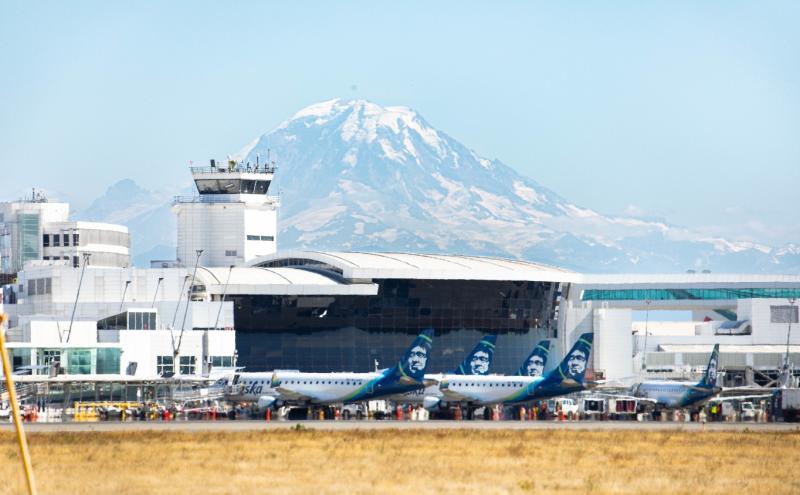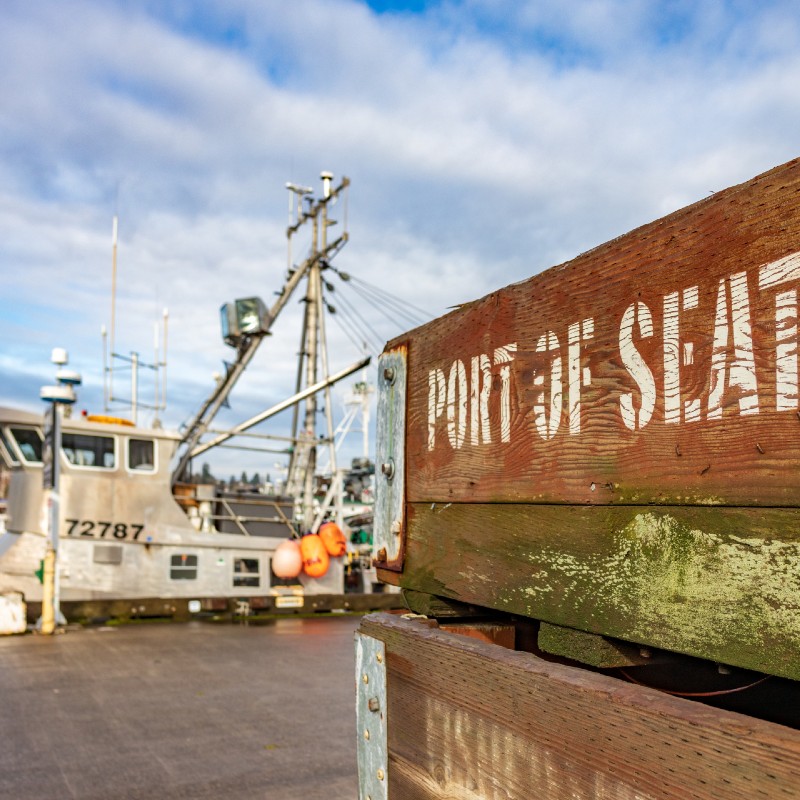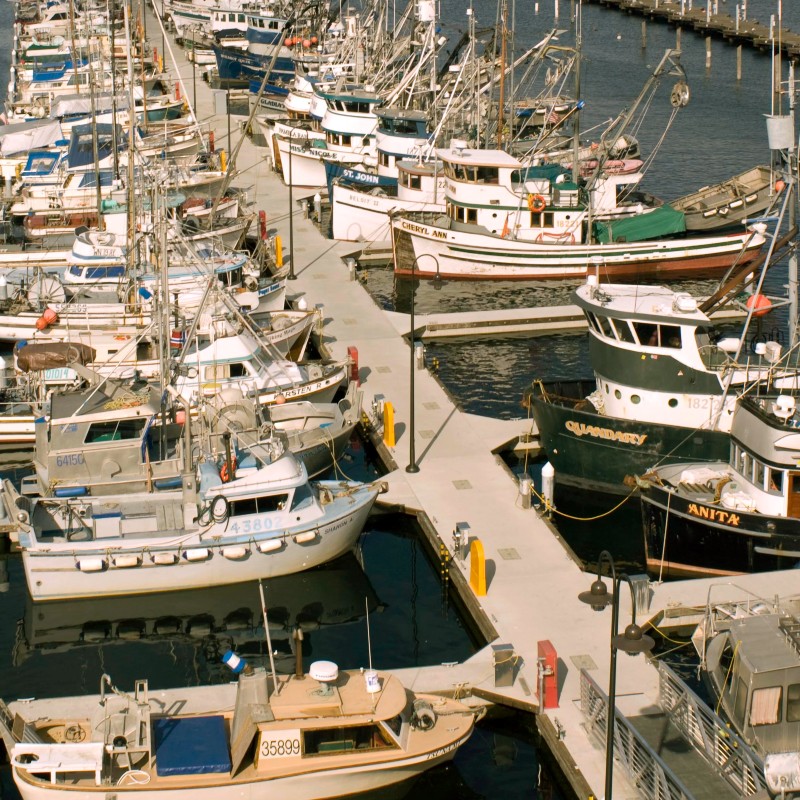
The Port of Seattle’s Hazardous Waste Program ensures proper management of hazardous waste streams through educational and technical assistance efforts that emphasize compliance, waste minimization, and recycling.
What is Hazardous Waste?
Hazardous waste presents a risk to human health or the environment. It can be generated from many sources, including industrial manufacturing process wastes and batteries, and can include liquids, solids, gases, and sludges.
The Port of Seattle is responsible for managing hazardous waste from its inception to its final disposal. In Washington State, the Dangerous Waste Regulations (Chapter 173-303), which align with the federal Resource Conservation and Recovery Act (RCRA), outline what constitutes hazardous waste and the appropriate methods for the Port to manage and dispose of it.
At the Port, the process typically includes the following fundamental steps:
- Designation (Is your waste hazardous?)
- Maintain our generator category
- Implement proper containment and labeling
- Maintain accurate recordkeeping
- Arrange for waste disposal or recycling
The Port of Seattle is required to assess their generator category monthly. The specific regulations that apply depends on the quantity and type of hazardous waste generated during a calendar month. It's important to note that the generator category can fluctuate from month to month.
SEA Hazardous Materials Management
SEA began developing progressive pollution prevention strategies in 1995. Over the past twenty years, SEA successfully reduced the amount of hazardous waste it generates by more than 80 percent. Our ongoing discussions help raise awareness about the use of less hazardous chemical alternatives and decreasing our hazardous waste, even as the airport’s footprint continues to increase. Our work encompasses the following areas:
-
Maintain and adhere to an approve chemical products list.
-
Evaluate and approve all procedures and new chemical products.
-
Research and implement “green” product alternatives to replace hazardous products and prevent the use of more harmful alternatives such as isocyanates, chlorinated solvents, or other toxic solvents and flammable materials.
-
Maintain our small quantity generator status, even while our airport footprint increases. Learn more about what this status means at the EPA’s Hazardous Waste Generators webpage.
-
Prevent and manage spills at SEA through our robust emergency spill program.
-
Reduce hazardous waste by puncturing aerosol cans so they can be used as scrap metal, using lead-free and water-based paint for airfield and road markings, and minimizing the use of solvents to clean painting equipment.
-
Use high-flashpoint solvents and water-based part washers instead of flammable or toxic solvents.
-
Offer trainings on pollution prevent, waste management, and waste reduction strategies.
Maritime Hazardous Materials Management

The Maritime Environment and Sustainability Division manages around 25 facility sites. Although many sites are inactive, the Port of Seattle continues to maintain them to address any waste streams arising from Port activities or illegal dumping. Several sites are actively managed for both abandoned and operational waste.
The Maritime Division is committed to reducing waste through various strategies, including new hazardous materials reviews, strict aerosol purchase management, spill prevention and response, and product substitution (e.g., using water-based cleaners).
New Hazardous Materials Product Review
Objective: To reduce or eliminate the use of hazardous materials in operations.
-
This initiative ensures that any new materials used at the Port are reviewed for environmental impact, toxicity, and potential risks to health and safety.
-
By focusing on safer alternatives, the Port reduces the likelihood of hazardous material spills or contamination, which is crucial for protecting both the environment and local communities.
Strict Management of Aerosol Purchases
Objective: To control the types and quantities of aerosol products purchased and used in operations.
-
Aerosol products can be harmful to the environment due to propellants and chemicals that may contribute to air pollution or ozone depletion. Strict management ensures that only necessary aerosols are used and that they comply with environmental standards.
-
This approach helps to minimize waste generation and hazardous emissions while promoting more sustainable alternatives, such as pump sprays or refillable systems.
Spill Prevention and Response
Objective: To prevent and respond to any accidental releases of harmful substances.
-
Effective spill prevention protocols can avoid significant environmental damage, including soil and water contamination. This is particularly important at the Port, where hazardous materials like fuel, oils, and chemicals could be involved in operations.
-
Quick response plans help mitigate the impact of spills when they occur, reducing their long-term ecological footprint and ensuring a safer environment for both workers and wildlife.
Product Substitution
Objective: To replace toxic or harmful products with safer, more environmentally friendly alternatives.
-
Solvents can emit volatile organic compounds (VOCs), which are harmful to both the environment and human health. Using water-based cleaners, rather than solvent-based ones, significantly reduces the use of hazardous chemicals.
-
Substituting with safer products aligns with sustainable practices by reducing chemical waste, minimizing air pollution, and fostering a healthier workplace.
Maritime Facility Waste Management
The Port of Seattle’s Maritime Environment and Sustainability group effectively manages both operational and abandoned waste streams across several key facilities. Here's a snapshot of these efforts at different locations:
Fishermen’s Terminal
The moorage facility actively manages operational and abandoned wastes left on the docks. Waste is identified, stored securely, and prepared for proper disposal. Fishermen's Terminal promotes waste reduction through outreach and education, offering waste disposal outlets for customers. It also provides bilge water pump-out and oil recycling services for users.

Shilshole Bay Marina
As a large recreational marina, Shilshole Bay Marina manages various waste streams from dock boxes and solid waste locations. Waste is quickly moved to storage, categorized, and prepared for disposal. The facility offers antifreeze recycling, oil recycling, and bilgewater pump-out services. These services are essential to support over 1,400 moorage slips and a thriving liveaboard community.
Marine Maintenance – South Facility
The Marine Maintenance South facility is a prime example of waste minimization. Responsible for maintaining the Port's maritime assets, it has maintained Conditionally Exempt Small Quantity Generator (CESQG) status since 2012. This facility produces less than 220 pounds of hazardous waste per month through effective management and strategic product choices.
Seaport Environmental Incident Notification
The Port maintains a 24-hour incident notification line to manage water and land-based spills. The group ensures that appropriate notifications are made, and the responsible party responds appropriately. If no responsible party is identified, the Port steps in to handle the cleanup to minimize the impact on human health and the environment.
The Port of Seattle’s Maritime Division sets a strong example by combining preventive measures with sustainable operational practices. By carefully managing waste and hazardous materials, we not only reduce their environmental footprint but also align with broader sustainability goals including waste minimization, resource conservation, and pollution reduction.

